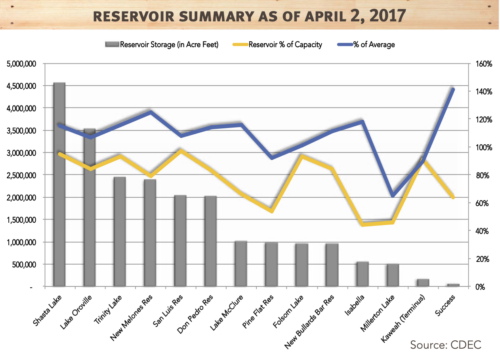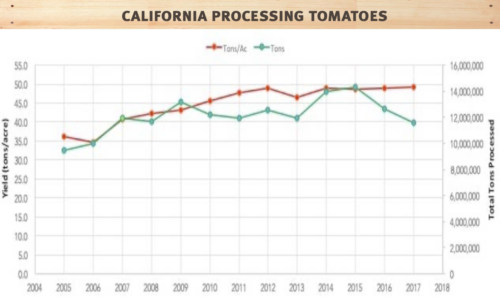California’s record rainfall and snowpack creates new challenges for growers
 A year ago, the topic of choice for anyone involved in California’s agricultural industry was the drought. Today, we face a record-setting snowpack and concerns over potential flooding in the State. What a difference a year makes!
A year ago, the topic of choice for anyone involved in California’s agricultural industry was the drought. Today, we face a record-setting snowpack and concerns over potential flooding in the State. What a difference a year makes!
A press release from the California Department of Water Resources showed that the statewide snow water equivalent (SWE, the depth of water that would result if the entire snowpack melted simultaneously) for March 30th was 45.8 inches, or 164% of the historical average for that date.
The major regions of California have all received good rainfall for the year. The Northern Sierra precipitation index is 199% of normal to date, San Joaquin is 191%, and Tulare Lake Basin is 177%.
Northern reservoir levels as of April 2nd are between 93-114% of historical average while Central reservoirs are between 57-121% of historical average. Many of the reservoirs that are below historical average are being maintained at that level to allow for the large snowmelt and to prevent flooding downstream.
The San Luis Reservoir, which provides a good source of water for agriculture in the Central Valley, is at 99% of capacity versus 51% a year ago. With a capacity of a little over 2 million acre feet, the San Luis Reservoir is an important player in our industry.
While the snowpack provides an excellent source of water to recover the levels of the reservoirs in California, groundwater sources (making up at least one third of the supply for California usage) may take much more time than a historically wet water year provides to replenish supply.
With all the good news about water, the South-of-the-Delta Central Valley Project Allocation has just been raised to 100% for the first time in a decade versus a 5% allocation last year. A 100% allocation in a Central Valley Project District like Westland’s Water District equates to about 2.6 acre feet per acre.
Despite the positive news, we still have to recognize that the water system in California is broken. Since October
1, 2016, over 32 million acre feet have flowed out to the Pacific Ocean, capturing only a little under 3 million acre feet pumped through the State Water Project Banks pumps and the Central Valley Project Jones pumps. The good water allocations may have arrived a little too late and are out of sync with crop demand.
Growing tomatoes in a particularly wet year can be tricky business. If water is available, farming tomatoes in a drought year with a dry spring may be easier than fighting wet soil to meet delivery curves. For example, heavy rains in February made it more difficult to get seedlings planted than in the past couple years. With storms arriving on 3 to 5 day rotations, planting windows are limited, leading to delays in deliveries.
 Looking at the overall market and intentions for total productions, the state has turned in a figure of 11.6 million tons for 2017 to be produced on 235,000 acres at a yield of 49.4 tons per acre. The question is: will this many tons be produced in a wet year?
Looking at the overall market and intentions for total productions, the state has turned in a figure of 11.6 million tons for 2017 to be produced on 235,000 acres at a yield of 49.4 tons per acre. The question is: will this many tons be produced in a wet year?
In the graph below, you can see that the tons per acre have been running around 49 tons per acre for the last 4 years. The last real wet year with delayed planting was 2006, where the yield was only 34.6 tons per acre. Other factors exist, such as the fact that drip irrigation wasn’t in full use and 2006 also had extended periods of days over 100 degrees. Varietal improvements have also been made since 2006.
Growers will need to minimize the compaction of the fields from performing operations on soil that is too wet and ensure that the roots are well sealed while transplanting (sometimes this is difficult when the planter slices into wet soil).
Field management of varieties delivered to factories will be more challenging in 2017 because of the limitations the field conditions has had on growers’ ability to plant the varieties they had planned. Morning Star maintains an advantage in this area, operating a system whereby many of the growers purchase plants from a Morning Star affiliate. This allows the risk caused by variability of varieties to be hedged through planning and schedule flexibility in our factories.
Potential for viruses are low this year, particularly because curly top and leafhoppers do not do well in wet years. Early counts have shown that populations have been small and the incidence of disease is low. Only 10,000 acres are estimated to need treatment in 2017 compared to 64,000 acres in 2016.
Discussions between processors and the California Tomato Growers Association began with offers between 8 processors and the CTGA in late January with an offer of $67 from processors and $73.25 from the CTGA. The settled industry price in 2016 was $72.50, and this year’s price settled at $70.50.

Morning Star Newsletter now distributed electronically
As a reminder, Morning Star is now distributing our newsletters electronically using an email distribution vendor called Mailchimp. Your e-version will now include informative Morning Star videos and highlights. Depending on your company's firewall, these emails may initially be directed to you spam folder.

